#anyway game is kyuuyaku megami tensei
Explore tagged Tumblr posts
Text
man 90s rpgs had the biggest, skungiest fucking menus (good thing). we should bring them back.
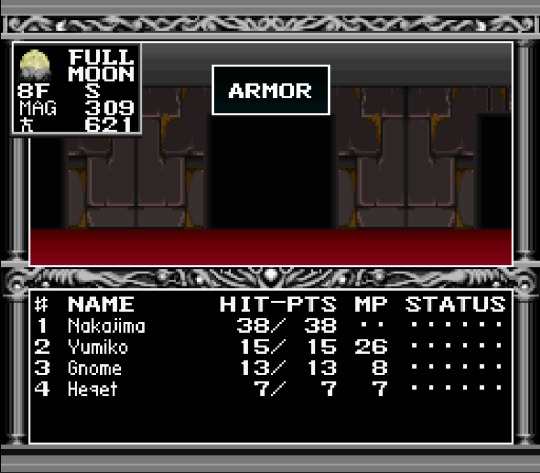
like this shit is huge!! and very cozy to me
#maybe atlus just likes making stylish menus#idk#anyway game is kyuuyaku megami tensei#i think it's pretty fun but for the rest of you who are normal#it's a remake of a late 80s dungeon crawling rpg#notably not a victim of atlus extra girl rerelease syndrome#probably cuz they hadn't started doing it yet lol
0 notes
Text
dungeon crawlers are awful painful hell games anyway i'm gonna play kyuuyaku megami tensei 2
2 notes
·
View notes
Note
For the SMT ask game, #14.
14. Best soundtrack
how could you Fucking do this to me. this is the most impossible task because almost every smt ost bangs and fucks and rips and i go to bat for 99% of them
but uhhh. i can divvy this up by era i think. and none of this is going to be coherent in any way but i think you should take my word as gospel because i'm right
The Early Years (1988-2000):
Majin Tensei II: SPIRAL NEMESIS
this shit SLAPS. the music in majten2 is, uh, quite frankly incredible on the SNES, and the composers (hidehito aoki, misaki okabe, yoshiyuki ito) were on some next-level shit when they scripted out bangers such as A.D. 1995 Story and Smash Up and remakes of two of the previous game's songs (which already were AWESOME) Flame Up Fragment and Bicarbonate of Face and and and,
idk play majin tensei. i'm about to become a majin tensei blogger and stan. did you know that almost all of the majin tensei manga is translated, and all that's left is the rest of vol 4 and all of vol 5? (grabbing your face) DID YOU KNOW!@!!!!
Shin Megami Tensei II
i mean. okay. you knew i was gonna bring this up. who do you fucking think i am. the whole game is wonderfully done and atmospheric, and even with the odd dumbass-theme playing in the BG i just, i dunno, i think it still gives me chills. loading up the game and watching the text scroll to the Title Demo is a lot, listening to that banging Battle theme is intense in a way that no other smt game has reached since IMO, and the Makai map theme is just... really sorrowful! these are the PSX songs because i prefer them over the muddied instruments they used for the original SNES game, but the original isn't bad either!
Megami Tensei II
i think everyone should bare minimum play Kyuuyaku Megami Tensei (2) at least once in their lives, but replace the ost with the original NES version because ohhh my gooooood holy shit there is SUCH a world of difference between the synths used vs the really muddied KMT instrumentation. that aside, the music is just... Good. the battle theme, Death Match, is incredibly intense, TOKIO Adventurer is a fun song to walk to on the overworld map (even being interrupted by demons every 2 steps), OMEGA is a REALLY good final boss theme... it's a bummer they don't get referenced more often! the last time they were was in Majin Tensei, and then again as a total throwaway in SMT5...
The 2000s (2000-2009):
Digital Devil Saga 2
both games go on this list imo, but i uh, i personally really like 2's ost more than 1's. i have no reason for this i just think it's nice. the battle theme Battle for Survival especially, but i just like the whole thing in general? sorry i have nothing else to say here
uhhh. i don't. have. anything else to put here. the other games in this category are good but their osts don't stand out to me... except for Strange Journey, which i. never finished. oougrhghhgfdnjdfjgdgh explodes IT'S SO GOOD THOUGH SO I?? HEARTILY RECOMMEND IT ANYWAY
The Recent Age (2010-Now):
Shin Megami Tensei V
don't talk to me about 5, but if you DO talk to me about 5, talk to me about its ost. of anything in that game, the music and sound direction REALLY stuck with me, it's probably the best the series has ever had to offer
i REALLY like Strength, and yes that is entirely because it feels like OMEGA of megami tensei 2 fame; but the regular battle theme Da'at is great too, and i spent an uncomfortably long time listening to fan recreations of it from the trailers because it was that fucking good to me. honestly the fact that there's so many different battle themes and they all slap is great, they're all fun to listen to. especially Destruction, like fuck dude did they really have to go that hard? (yes)
Soul Hackers 2
gnawing and chewing on 2's ost. i don't care how many people didn't like it, i did, and i think it's really well-done. very very atmospheric! Karakucho is wonderful, COMP SMITH is the GOAT (and i'm glad so many people agree with me!), and even the idiot theme, Cats and ladle, is... very cute! i never thought it out-of-place whenever the team started goofing off, since the idiot theme was never too jarring
... also, Battle of Devil Summoner is bumpin, i'm glad we got to hear this song so many times over the normal battle theme, because. hot damn
i'm not picking a favorite out of any of these are you kidding. except maybe majin tensei 2 that one is undoubtedly a beast. but like. i think everyone should play all of these games and experience their music and have your taste in music irrevocably changed against your will
#shin megami tensei#thanks for letting me infodump and lose my damn mind over these#its all i do any time someone asks me about the older games LOL#and also i needed a moment to go 'hey sh2 is good actually'#since i dont see that opinion too often in the fandom#ahuuhuuhuuh
2 notes
·
View notes
Text
Digital Devil Story: Megami Tensei II re-review
It’s not uncommon at all for the very first game in a long running video game series to have significant differences from its later installments. Later sequels already have a foundation to work with, and thus have more room to simply focus on adding new features and mechanics, or simply polishing existing ones, meaning that many mechanics and quality of life features that often become very familiar to players and may well be essential to the identity of a series only originated from a sequel. This is the case with Shin Megami Tensei, to an even larger degree than some other series. If one were to ask me where SMT truly began, I would answer with Megami Tensei II, the sequel to the very first SMT game, Megami Tensei, and the predecessor to the proper Shin Megami Tensei I that would be released on the SNES. Along with many mechanics and improvements, Megami Tensei II also brought the series forward in areas like setting, story, and aesthetics. This is honestly a fascinating game to me, and thus, I’d like to take a second look through it, with a re-review similar to what I wrote last time on Megami Tensei I. Before we start though, I’m not going to focus much on core mechanics that already appeared in my MT1 review, which can be found here, and secondly, there will be full game spoilers, for anyone who cares about that. Anyway, with that said, let’s get to it. As with MT1, I played the SNES remake, Kyuuyaku Megami Tensei.
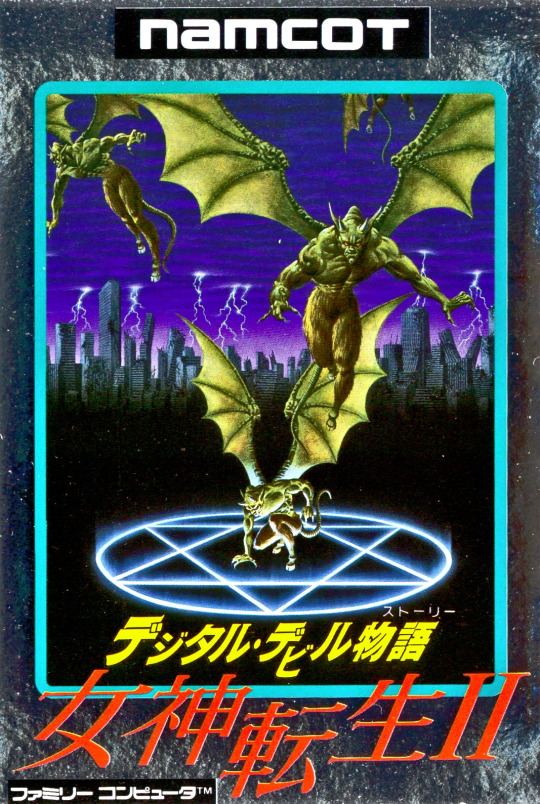
Story:
In the year 199X, humanity was devastated by a nuclear war that destroyed civilization and opened a passage between the human world and the Expanse, leading to demonic hordes quickly conquering the remains of the world and oppressing what was left of humanity. Tokyo in particular was directly hit by a missile, with the demon lord Bael soon establishing dominion over the surface, forcing the survivors to take refuge in the ruins of Tokyo’s wards, or, for the fortunate, in shelters that offer those who live in them safe and comfortable lives. 35 years later, two young residents of one of these shelters, Takuma and Ryu (two characters who are nameable in game and lack default names, but will be referred to by the names given to them in the gamebook Messiah Project 2036), accidentally release a demon called Pazuzu while playing a mysterious video game known as Devil Busters. Pazuzu, who claims to be God’s messenger, declares the two to be the Messiahs who will free humanity from the rule of the demons. In order to aid them in accomplishing this, Pazuzu gifts Takuma with a COMP, a portable device that allows its user to communicate with and summon demons, and grants Ryu the ability to use magic, afterwards guiding them to meet up with one of his servants, Orthrus, and instructing to the duo to kill a witch named Asuka (another nameable character) who betrayed Pazuzu.

Upon confronting Asuka, however, she explains that she believes that Pazuzu merely wishes to replace Bael as ruler of Tokyo, and is using the “Messiahs” in order to accomplish this. While Takuma agrees with her assessment, Ryu, having grown accustomed to the praise and sense of duty that acting as a Messiah has granted him, sides with Pazuzu and abandons the two. Teaming up with Asuka in order to properly free Tokyo from the rule of the demons, Takuma begins to journey through the ruins of Tokyo’s wards, collecting the Seven Pillars of Solomon along the way, artifacts that, when placed at the center of the nuclear missile’s impact, will grant access to the Expanse, and allow the two to take the fight to its demonic rulers, led by Lucifer, formerly imprisoned in ice after his battle with Nakajima, only to be freed by Ryu.
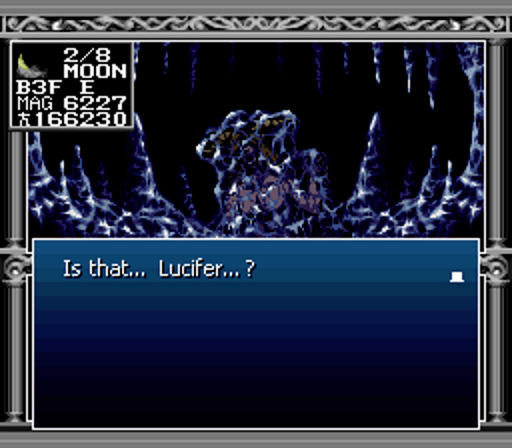
Immediately, Megami Tensei II’s plot is an improvement over the first game’s plot. Most prominently, it establishes the post apocalyptic setting that would become common for the series. That said, for the most part, there still isn’t much plot to be found, as most of what happens are unrelated, fairly random events scattered across all the different locations visited, such as dealing with cults consisting of humans brainwashed by demons, a living island swallowing the protagonists and forcing them to traverse its insides, and even Takuma getting his left arm bitten off by a trap guarding one of the pillars, forcing him to get a cybernetic replacement. Yeah. This is genuinely one of the weirdest games I’ve ever played. There’s also not much really tying it together with the plot of the first game, besides a few references. That said, it does get a bit more interesting towards the end, assuming one is on the path to the good ending, which is where we enter full spoiler territory.
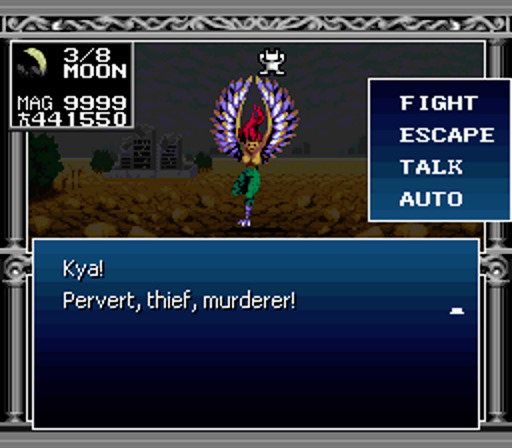
Upon defeating Bael, he turns into a frog that Takuma is able to take with him, and upon confronting Beelzebub, Lucifer’s right hand man, with the frog along, Beelzebub reveals that he and Bael were once the Canaanite god Baal, split in two by none other YHVH/God. After allowing them to return to their original form and traveling through Lucifer’s temple, Lucifer further reveals that YHVH had demonized all other gods in order to ensure uncontested rule over humanity, and that Lucifer himself was an angel cast out of Heaven for giving humanity the gift of wisdom, with humanity proceeding to worship Lucifer himself in the hopes of gaining even more knowledge. In anger, YHVH instructed Satan, his servant and a former ally of Lucifer, to cause the nuclear war and eradicate humanity. Allying with Takuma in order to defeat Satan, they afterwards take the fight to YHVH himself in order to rid the world of demons and ensure humanity’s survival.
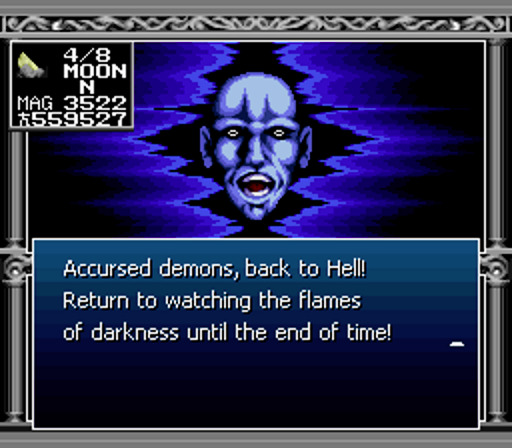
Yes, this game let you fight God before even SMT2 did. In one move, this establishes the central conflict of Law vs. Chaos that would become so important to the series, YHVH’s dethroning and demonization of other deities, establishes Satan as YHVH’s right hand, and Lucifer’s commitment to fighting YHVH above all else. It’s also the introduction of multiple endings to the series, as you can either betray Lucifer at the last moment and join with YHVH, or never even properly ally with Lucifer by instead killing the frog, refusing to fuse Bael and Beelzebub together, or denying Lucifer’s offer of alliance, which instead gives you a bad ending where YHVH gives Takuma and Asuka a home in the Millennium Kingdom, turning the two into gods. That said, it’s all still not as developed as in later games. YHVH is just focused on eradicating humanity outright, the very involvement of the Law faction is kept secret until very late in the game, Satan is just a smug, malicious sycophant lacking any depth, and Lucifer is portrayed as a straight up good guy, rather than being just as dangerous as YHVH. Still, it’s incredible just how many series traditions were added here, and even if the end result is still lacking, I can’t help but appreciate it.
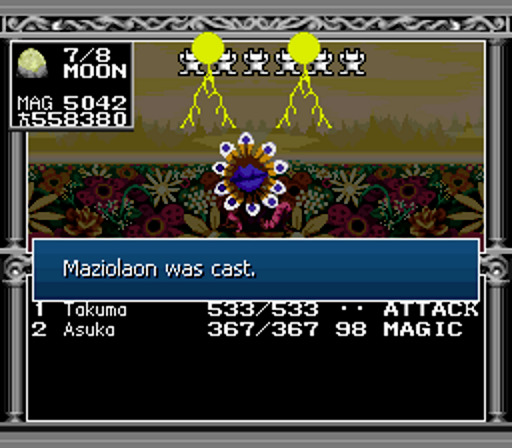
Gameplay:
The basic gameplay of Megami Tensei II is mostly the same as the first game, so I won’t reiterate too many points from there. Probably the biggest addition is that, instead of taking place in one gigantic labyrinth with multiple areas, there’s now an overworld map that allows you to explore the surface of Tokyo and travel to different individual towns or other areas. You can still encounter enemies on the overworld, and in fact the encounter rate for it seems even higher for it than normal, but magnetite isn’t drained even while you have demons out, which makes it much easier to get from place to place. This overworld does a lot to help the pacing, as there’s now many more locations to visit, meaning dungeons are much, much shorter than in the first game. In addition, instead of saving the game at village elders, terminals have been added, which perform the same function, but also allow you to teleport between them, making it so much easier to backtrack or get to different areas if, for instance, you’re looking for specific demons to use for fusion. Buildings and other areas within towns will still have random encounters if they’re explorable, but it’s still not too bad to deal with.
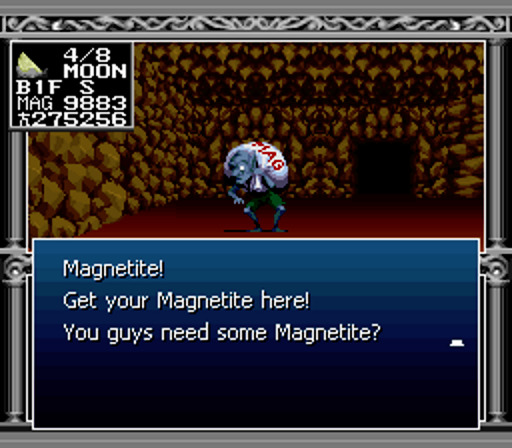
Combat isn’t too different, but there have been some additions. Most notably, guns are now a separate weapon for the humans to use, though unfortunately they’re pretty underutilized. They’re more effective against enemies made of flesh and blood, with melee weapons being more effective against enemies with thin or intangible bodies instead, and in the early parts of the game, this dynamic holds up. Later on, however, guns drop in effectiveness pretty hard, and while they do generally still hit more enemies per round than melee weapons, you’ll soon find yourself switching to melee full time. On that subject, shops no longer sell melee weapons, instead only selling guns and armor, leaving melee weapons to only be dropped by enemies, which is a system that honestly just frustrates me. Luck now apparently increases drop rates from enemies, but on average, it seems to be pretty rare for them to drop anything, which is pretty terrible when you can’t even find weapons in treasure chests, with only three weapons total being given through events, all of which are near the end of the game.
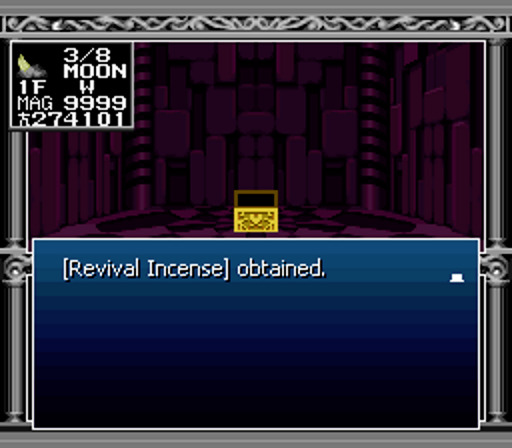
Armor now does more than just increasing defense, and different categories of it give boosts to one’s stats. Helmets typically increase intellect, gloves increase strength and occasionally vitality, boots increase speed and occasionally strength, and capes, a new category of armor, increase luck, with these boosts applying even if they go past the natural stat cap of 35. Some pieces of armor also give resistance to certain elements, further increasing the protection they give. This is all great, but it’s contrasted by a horrible, horrible increase in price. Money is already pretty tight in this, what with needing it to summon demons in the first place and pay for healers, and equipment is so expensive that it actually feels like you aren’t even expected to get more than a few pieces across the whole game. Even abusing casinos, which are more common than in the first game, and the sole source of capes, at that, every new shop you come across will quickly drain you of everything you earned. I really don’t understand what they were trying to do with this, but when you price equipment for over 100,000 macca by the end of the game, when enemies barely drop anything and even casinos will only earn you about half of that per round, you’ve screwed up somewhere. There’s also a few pieces of equipment, namely Lucifer’s armor, the best armor in the game, and Lucifer’s sword, one of the best swords in the game, that actually have stat requirements, with Takuma needing 20 base intellect to equip Lucifer’s sword, and needing 30 vitality and 25 intellect to equip Lucifer’s armor, though stat boosts do count in this case, saving you at best 2 points of vitality and 4 points of intellect with the best gloves and second best helmet. If you know about it in advance, it actually gives a nice incentive to level intellect on Takuma, since it might otherwise seem pretty pointless if one doesn’t know about its effects, but considering these are given at the end of the game, someone playing blind will find these pretty nasty surprises

In terms of other improvements when it comes to combat, spells have been added and even overhauled a bit. Buff and debuff spells are more common than in the first game, and they do have a noticeable effect as long as you cast them twice, and demons overall generally come with a nice spread of supportive spells to help make your life a bit easier. Asuka’s selection of spells is pretty different from Yumiko’s from the first game, learning Zio spells instead of Agi spells, which is much more useful, and learning Traesto and Tranpa, letting her teleport the party out of dungeons and teleport back to the last used terminal respectively, making getting around even easier. Incenses, the stat boosting items in SMT, have also been added, with 5 total incenses for vitality, intellect, and strength, 4 for speed, and 6 for luck scattered throughout, less than in later games, but still enough to give some nice boosts. There’s many more bosses than in the first game, all of which give pretty great amounts of EXP and help spice things up just a bit, and some even belong to optional side areas. There’s also a proper tutorial, in the form of the Devil Busters game, which introduces overworld movement, demon recruitment, and gives actual explanations about many mechanics, such as moon phases, fusion, magnetite, and what stats actually do. Additionally, there’s no negative consequences for dying in Devil Busters, so you can just continue afterwards. It’s a much kinder introduction than one would expect, and it’s extra neat to play because it’s actually based off the Tower of Daedalus, the first dungeon in MT1, down to the music.
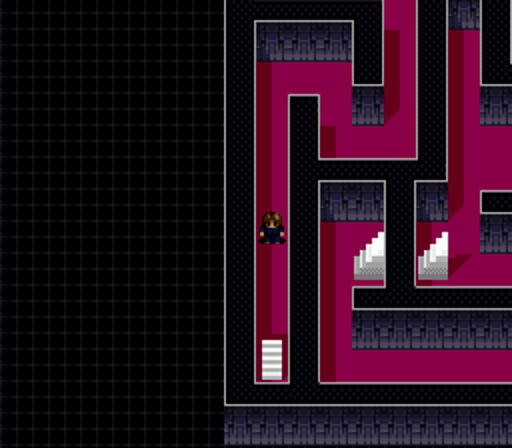
However, the most interesting additions and changes are those made to the demons. As before, they’re still only sorted into evil, neutral, and good demons, with neutral demons being recruitable from random encounters and good demons being fusion only, but the amount of them has been expanded pretty nicely. The first game only had 142 demons total, with 65 of them being neutral or good. MT2, on the other hand, has 250 demons, with 121 of them being evil, 64 being neutral, and 65 being good, meaning there’s actually a few more useable demons than enemy only ones. Obviously, this increases the scope of it drastically, and ensures that almost every level Takuma gains opens up another demon or two to use. Demons also have much more focused stat lines, with many of them focusing on stats like vitality and strength at the expense of speed and intellect, for instance, which theoretically makes them more focused than the very balanced stats that good demons in MT1 would have by the end. Unfortunately, this actually just hurts the viability of many of them, especially those with low intellect, as many bosses in the Expanse and endgame have very damaging spells that will wreck anything without high intellect. There’s also several demons that can be acquired through events, with them often being unique and usable regardless of level, which is very helpful.
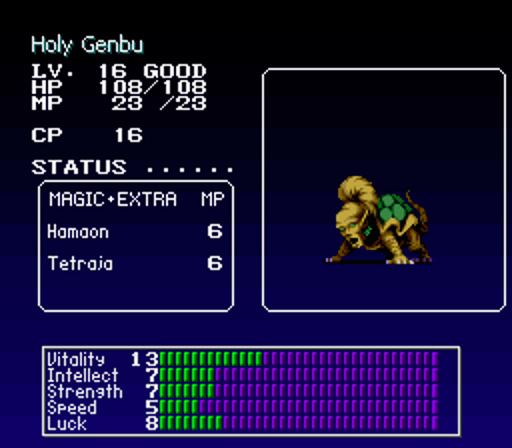
The mechanic related to demons that was overhauled the most, however, is fusion. Most importantly, instead of needing very specific demons to get specific results, like in MT1, the much more familiar formula of the races of the demons used plus the average of their levels determining the result is introduced, with the result always rounding up if it isn’t exact. This system is much more forgiving and easy to use than the first game, and it’s made even better through the proper introduction of elements, who, when fused with certain races, will always make the result the next highest demon in that race. For instance, fusing Salamander with an Avatar demon will always result in the Avatar above the Avatar used. Since demons still don’t level up, and there’s no skill inheritance, there’s no downsides to using elements, so you can keep your demons upgraded throughout the game pretty easily, if still tediously. The only races that can’t be upgraded through this method are the Fairy, Element, Divine, and Deity races.
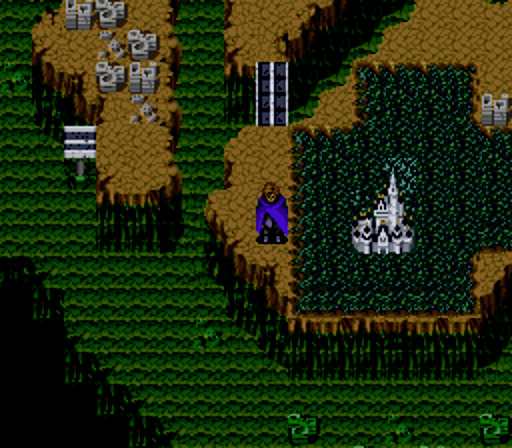
Also introduced is triple fusion and special fusion. Triple fusion can only be performed with good demons, and obviously uses three demons at once, compared to the normal double fusion, which uses two. Special fusion deviates from the normal formulas and produces special results when fusing specific demons together. These aren’t too important usually, but the Kishins Zouchouten, Koumokuten, Jikokuten, and Tamonten can be made through special triple fusion in addition their normally much harder requirements, Divines can only be made through triple or special fusion, and Deities can only be made through triple fusion, with the ultimate fusion demon, Shiva, only being obtainable through triple fusion using some of the strongest demons in the game.
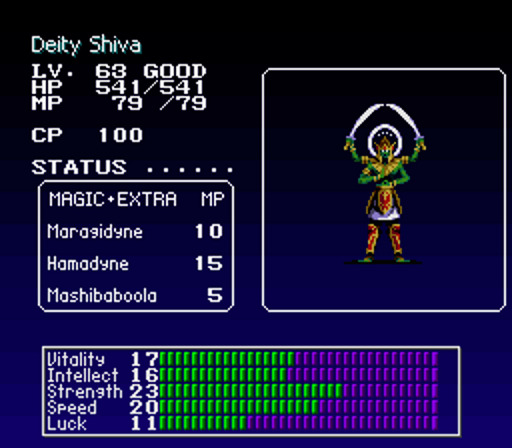
While most of this is much better designed than in the first game, there is one bizarre series of occurrences that I really need to go on a tangent about, that being everything to do with the Divine race. Consisting of Uriel, Raphael, Cherubim, Nike, Gabriel, and Michael, as stated above, they can only be acquired through triple or special fusion, though in actuality, Cherub and Nike seem to be the only ones acquirable through normal triple fusion, and even then, only if you’re clever. The archangels all require special triple fusion with elements, Cherub otherwise requires a fusion of Sword Knight, a one time event demon, and Sylph, and Nike requires Valkyrie fused with Ocypete, Aello, or Celaeno. The problem with all this is that, by the time you can do most of this, they are horrendously outclassed. Uriel and Raphael, level 13 and 20 respectively, both require Salamander, a level 38 element, Sword Knight is far better than the level 27 Cherubim, and Valkyrie is level 57 and only appears in the second to last dungeon in the game, at a time when the level 35 Nike has long lost its uses. Most of these mentions demons have poor stats even for their levels, and the only real advantage they have is Samarecarm, a resurrection spell that is worth far less than the developers seem to have thought. Gabriel and Michael are actually quite good, with Michael in particular being viable even to the end of the game, and are much easier to acquire, which really makes me wonder what the devs were thinking with the rest of this race.

In one finally note in regards to the gameplay, there’s actually a fair amount of easter eggs that can be accessed in the SNES version of this game, with most of them only being accessible if one played through MT1 first and did certain actions there. These range from Izanami giving you a robe that allows you to safely cross damage tiles if you gave her silk thread in MT1, being able to acquire a restorative item from Rag’s shop if you entered it at least twice in MT1, which combined with a piece of equipment you can win at casinos, allows you to acquire Qing Long, Bai Long, and Kali, three endgame demons, for free at any Cathedral of Shadows, to, most prominently, gaining access to three small bonus areas if Bael is killed as a frog, wherein you can find Artemis, Leto, and Apollo, three demons exclusive to this version who can then be specially fused to make Zeus, who has a hilariously bizarre design in this game. It’s pretty cool, but all these exclusive demons, Zeus included, are just copies of other demons statwise, most of which are acquirable through the good ending route for free, and since you have to lock yourself into the bad ending to access any of this, it’s a novelty at best.

Overall, the gameplay of MT2 is much more refined than its predecessor. The improvements to fusion and the addition of the overworld alone helps the pace a ton, and makes for a much more fun game. That doesn’t mean it doesn’t have moments of bad design, as the encounter rate actually feels even higher than in the first game, and the Expanse has some miserable areas, mainly the Forest of Confusion, which contains several caves the COMP doesn’t work, preventing you from summoning demons within them or even using the automap, and also contains Astaroth’s castle, which starts with Asuka being kidnapped, forcing you to trudge through the entire dungeon and fight Astaroth himself without your dedicated healer. It’s horrible, needless to say. All the same, though, I did have some amount of fun with this game’s gameplay, which is more than I can say about MT1.
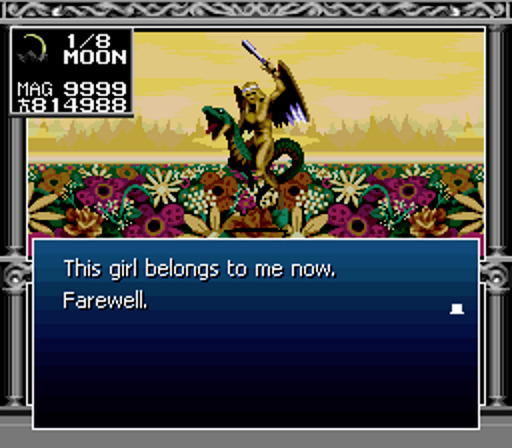
Graphics:
The visuals of MT2 are actually a good improvement over MT1. It still has the same bland, repetitive dungeons, but the overworld is actually pretty neat to look at, giving the main character a pretty cool looking sprite, and both Tokyo and the Expanse look properly gruesome to explore. As for the demons, the visual highlights of most SMT games, they’ve been improved as well, courtesy of Kazuma Kaneko, the series main artist, actually working on this game, unlike MT1. This means many demons now have much better looking designs, with many of them looking plain cool, and compared to MT1, which had many, many of its sprites changed for the SNES version, MT2′s SNES sprites are much closer to their original versions. Many demons, such as Lucifer, YHVH, Astaroth, Barong, and Girimehkala have designs pretty close to their later, more iconic ones, and so many iconic demons were introduced in this. In addition to the above mentioned ones like Shiva and the Archangels, Pixie, Vishnu, Pyro Jack, and even Jack Frost himself first debuted here. That said, several designs, like Beelzebub and Satan, are much more different, and there’s still plenty of weird demons, like man eating plants, several directly based on the Coin, Wand, Cup, and Sword minor arcanas, and even several possessed humans, based on heavy metal fans and Jason Voorhees. I’m not kidding. Still, it’s a significant step forward, and makes for some cool enemies to fight.
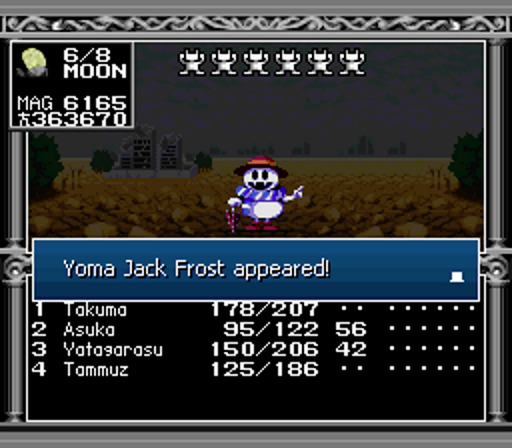
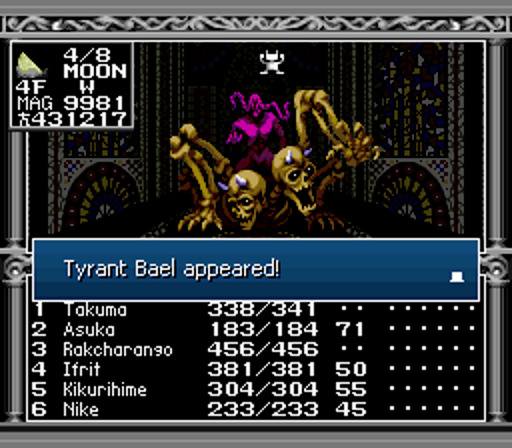
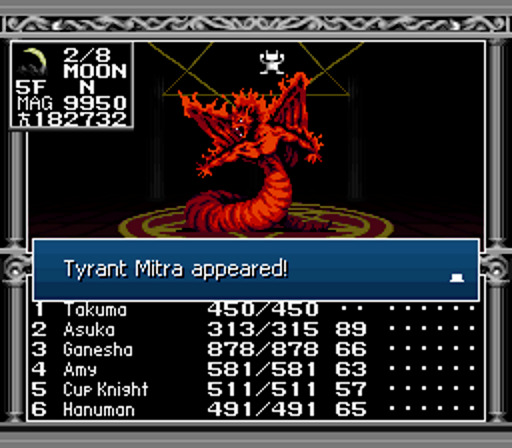
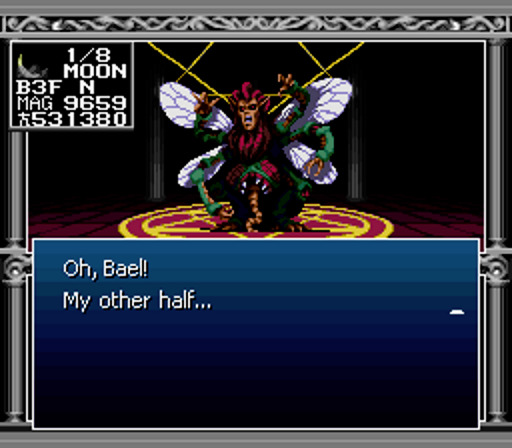
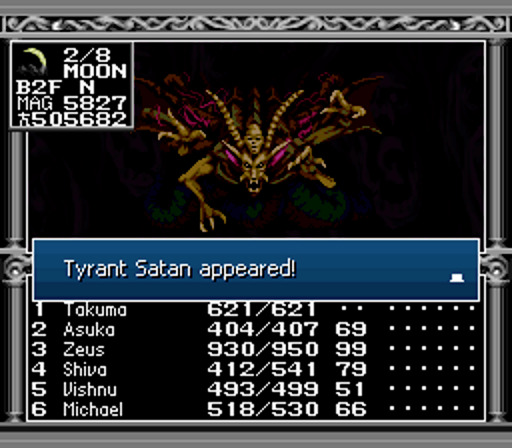
Music:
The soundtrack to MT2 is also an improvement over MT1, which already had a decent soundtrack. The main reason for this is that the cartridges used memory mappers that included extra sound hardware, resulting in the original Famicom version of MT2 having one of the richest 8-bit soundtracks ever, courtesy of Tsukasa Masuko, a soundtrack which was very faithfully remixed for this SNES version. From the rocking battle theme Death Match, to Explorer, the theme for exploring buildings in Tokyo, to the overworld theme for the Expanse, Hallucination, and especially OMEGA, the boss themes for Satan and YHVH that even has different mixes for both of them, it’s a joy of a soundtrack to listen to, and it’s worth a listen even if the game itself is unappealing to you.
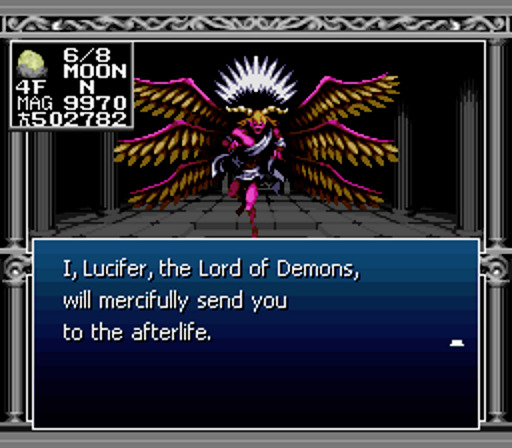
Conclusion:
Overall, Megami Tensei II is unfortunately still not a game I can recommend. It’s a big improvement, absolutely, and I’d even say it’s up there with Dragon Quest III, Dragon Quest IV, Final Fantasy III, and MOTHER in terms of the best designed Famicom/NES RPGs. However, best designed is only relative. It’s still grindy, frustrating, obtuse, and cheap as hell. It’s much more playable than Megami Tensei I, but still undoubtedly more than most would be able to handle. That said, if you’re really, really interested in the very beginnings of SMT, this is worth a look, at least. It properly set down the foundation for one of the biggest RPG franchises today, and it’s still impressive to see how much it did.
With that, we’re finally done here. With my replays of these two relics out of the way, I can finally move into new territory with this series, and I’m quite excited to do so. I can actually say with confidence I’ll be playing a lot of SMT this year. Till next time.
-Scout
10 notes
·
View notes
Text
Digital Devil Monogatari: Megami Tensei II
(Part 2 of a series of posts on the franchise, I guess...)
As the novels went on to expand on the wackiness of the first 2 titles and keep the story mostly consistent in terms of setting and tone, keeping the same protagonists and offering a pretty direct continuation of the story, the game series decided instead to recontextualize everything and move the story to post-apocalyptic tokyo. Also, they reworked some of the mythos and demon characterizations, possibly at the time with the purpose of offering an experience that would suit the demon recruitment system better. Of course, this would end up meaning that MegaTen 2 laid out many of the building blocks that the franchise would later welcome into its setting, and it could be said that the series truly begins with this game. Or maybe with Shin Megami Tensei just after it. Or maybe the telenet version from before MegaTen 1 that has no connection with Atlus, plays like old Gauntlet games and in which Set is weaker than Loki. You decide.
Anyway, MegaTen II is a huge improvement over its predecessor in almost every way. There is an actual plot that makes a few twists and turns as you go along (and, notably, starts with a big, involved meta reference to MegaTen 1, which was pretty surprising to me); there is a top-down overworld linking places together, a welcome cue taken from other RPGs that were making themselves known at the time; the music is really awesome this time around, courtesy of a sound chip designed by namco (which, unfortunately, is rendered moot in the remake, but hey, credit where credit is due) that expands sound channels and makes the NES sound very clean; the graphics are still pretty cool (and, in Kyuuyaku, the overworld looks very, very good, particuarly the underwater parts of tokyo) and the interface was reworked to be more user-friendly, along with several new features that have been added.
That said, though, it is a pretty technically impressive game, but some of the more base, "essential" issues of the previous one can still be observed in the sequel. Once again, long treks through dungeons don't feel very stimulating. Battles are easier than ever and, besides the return of great stuff like the level-drain and introduction of spells like Mudo and all the fun that brings, they need even less player input than before. The introduction of guns makes the early to midgame a joke, and extremely powerful melee weapons make the late game a joke. You're gonna be hitting that auto-battle button an awful lot in this game, so get used to passively watching your guys massively overpower everyone until someone gets the unlucky end of a curse's hit rate, or you decide to fight Tiamat well before you should.
Still, the more enjoyable, more sectioned exploration with clearer goals, mixed up with more fun setpieces and interactions make things actually much less bothersome this time around. Large sections of the plot are dedicated to finding a collection of McGuffins, and while that always runs the risk of looking like padding for sections where the designers were slacking off on plot, there are a number of weird ways you actually come across the McGuffins themselves, so it keeps things fresh by adding a modicum of variety to them. It's also nice to go around exploring tokyo trying to collect everything. Furthermore, the more farfetched, loftier but clearer goal means that there is more satisfaction from the player in finding out things for themselves as they slowly build toward something, contrasting the previous game where the constant, shorter fetch quests felt like an endless, pointless string of errands straining your patience. Funny how these things work out, huh?
Plot-wise, this is the game in which stuff actually starts happening. It's surprisingly character based for a while, then turns into a collection of setpieces, then goes back into a linear, sort of stage-like structure before the end. I think it shines when it's experimenting with weird circumstances. Perhaps the most memorable moment to me is a part where, in order to progress, you need to voluntarily have your character commit a stupid mistake that results in the amputation of his arm, just so you can go back to a cyber lab you may have visited previously and get your missing arm replaced by a robotic one, all the while walking around losing HP and unable to perform certain actions in battle because of your lost arm. There's really no story going on here, it's just the game being quirky with its setpieces and working gameplay into that, and it works quite well.
I will say, however, the overall story made no damn sense to me. It seemed like you were fighting for a certain faction, then it's revealed that it was all actually a ploy and the real enemy is the one you were fighting for, but then, for all intents and purposes, future actions you take in the game - if you opt for the good/more complete ending - seem to still forward that faction's agenda, so... I don't know, it's a mess of betrayals and revelations that probably didn't go through many drafts. It's entertaining, though. Maybe I'm just dumb and didn't get a pretty simple plot, I dunno.
Also, as it starts getting close to the end, it gets repetitive. Most of the third act revolves around a pretty flowcharty progression structure where you go somewhere, there's a town there, then you head to the local dungeon, fight a boss, get their item which allows you to go to the next place, rinse and repeat. It starts feeling a lot like its predecessor, like you're running errands and not accomplishing much of anything, just waiting for the story to take you to the next cycle of the same crap, but it's nowhere near as annoying. I also heard that there are crucial clues as to how to progress in two specific spots that weren't present in the original version of the game, so there's your daily dose of old videogame bullshit padding right there. I'm glad the remake fixed that, though, because I definitely wouldn't have been able to beat the game without a guide otherwise, and guides sour the experience a lot, especially in these cases where exploration and figuring stuff out is basically the name of the game. Good on you, Kyuuyaku, for adressing the issue and making things not soar into the ridiculous.
Another gripe I have with it is that, if you opt for the good ending, the game basically gives you everything you need, no strings attached. The most powerful weapon in the game, some of the most powerful demons in the game, and the most powerful gun in the game, just like that. Kinda takes the tension off the final battle when it's so obvious anyone could have done it, and it takes the focus off the demons you tried to fuse and make strong by yourself (unless you know what you're doing and you can actually fuse a demon stronger than the one the game gives you, which is unnecessary). Also, the very last dungeon is super underwhelming, definitely not what I expected after the whole third act. Like, the final boss is just there, dude, after a normal corridor. It sucks.
Still, however, the particular reworking of demon personalities and the intro to their philosophical standings in the world formed the basis for how they would act in the franchise ever since, and MegaTen 2 has a much more important place in the series canon than its predecessor. That, along with its setting, tone, and gameplay changes, codified what later SMTs would basically be all about. I think this game deserves a 6 out of 10, maybe a few tenths higher for possible cool stuff I missed. It's more streamlined, more expansive, and more passionate than its predecessor. It has a bigger impact on the franchise, and it introduced far more things that would become series staples than 1 did (like Jack Frost!). I definitely enjoyed it way more than I thought I would, and if you can stand the relative boredom of a simplistic, undemanding combat system and the rudimentary plot of a 1990 NES game, I think MT2 is worth your time, even if just to check out how things began and how they evolved from MT1. Hell, I liked it, anyway.
Oh, also, guns have their damage output affected by your strength in this game. Like, what?
3 notes
·
View notes
Text
Digital Devil Monogatari: Megami Tensei
Possibly part 1 of a series of posts on the whole series, maybe?
So, the first game in the popular MegaTen franchise is, wouldn't you know it, kind of weird. It was actually a video game sequel to a series of two novels starring a sort of villainous protagonist and the (government-mandated to exist ubiquitously through japanese media) high school exchange student as they become indirectly related to the summoning of ancient bad dudes Loki and Set through the magic of 80's computer programming, go into historic japanese landmarks to resurrect shinto goddesses, witness horrific, gruesome, sometimes sexual actions from the demons, go to space, fight using gods that turn into swords, and generally have a good time.
Naturally, considering the, um... Notorious source material, it's only logical that the videogame adaptation would, then, turn the sort of dark, villainous, intelligent programmer guy into a blank slate warrior with no personality, the girl into a standard RPG magic user, and drop them into a big dungeon crawl with almost no plot, nonsensical NPCs and a connection with the novels so tenuous they might as well have just taken some inspiration from it and opted to create a more original IP instead (I dunno, maybe put a "shin" in front of the title or something). Thus is born the antiquated experience that is Digital Devil Story: Megami Tensei.
While Japanese gamers did at the time have the original version of Dragon Quest - with the sprites that always faced down and the lack of a save system - ushering in a new style of role-playing gameplay into the mainstream, I suppose the mindset of RPG development was still rooted in the design philosophies of the western games from throughout the decade that were distilled into DQ. Games that, like Megami Tensei, typically featured a simplistic first-person view and a party of six characters, following the rough guidelines of the most recent version of D&D, and had generally no plot development, consisting instead of a hardcore, punishing trek through a few 20x20 grid mazes full of traps and gimmicks.
Furthermore, this type of experience, from what I heard, was huge in Japan, so it's no wonder Atlus chose to capitalize on that market instead of streamlining it and risk losing fans of the genre that were looking for an experience similar to what they had witnessed from RPGs so far. Less cynically, it's also entirely possible the developers themselves were huge fans of the first person dungeon crawler and wanted to replicate their positive experiences in a passionate love letter to the genre. Also, for what it's worth, they did add uniqueness in party management and customization, as you surely already know, but we'll get to that later.
I guess we'll never know the true context behind the original MegaTen's creation, but the point is, this is a very old-school game. I don't think it's nearly as brutal as the ones that inspired it, but it is also definitely far from holding your hand. At no point in the game is it entirely obvious exactly where items you're supposed to collect are located, so you mostly have no choice but to comb the entire dungeon yourself until you stumble upon the stuff you need to progress. Furthermore, sometimes the very NPCs that tell you there's even something to look for at all are slightly out of your way, so there's always the mental pressure of maybe having left something behind and having to backtrack and go to all sorts of places trying to find it when you run into the next dead-end.
By itself, this isn't really a bad thing. As an exploration-based dungeon crawl, it's expected that the player will have some agency over what they're doing, and it's refreshing to see a game where you have so much ground to cover, but with hardly any setpiece to spice up the crawling in terms of context, the job of entertaining the player falls squarely upon the gameplay's shoulders.
To that end, the gameplay is definitely more boring than stimulating. This is where I have to admit, I beat the Kyuuyaku Megami Tensei remake version of it. I have played the original, though, and I am aware of the differences between versions. I have also played future games in the franchise with the same issues, so there's no evidence that the original is much different in this regard. Anyway, apart from an intense earlygame where you're at risk of death from a stray Zan spell cast by a gnome if you're unlucky, the rest of the game's fights are uneventful, once you level up enough and have an array of serviceable demons at your side. There's only ever one group of enemy demons per fight. There can be up to eight of them, but all eight are the same type of demon, and the graphics will only show the one until the entire group is dead. It's kind of like every fight is against only one demon but the demon can attack several times and has an erratic, huge HP pool. Furthermore, targeting is completely random for all moves, and you'd think this would add a fake layer of frustration, but the game gives you an auto-battle option. It simply makes the entire party use their regular attack for as many rounds as you want and prevents text from popping up on screen to slow down the monster-slaying, but for the most part, this is more than enough to get you through whatever part of the dungeon you find yourself in, with only the occasional, very rare exceptions of either:
-A demon that has a dangerous ability, therefore making it so that you want to kill them as quickly as possible;
-A boss;
-A battle that you got yourself into without noticing your HP is getting low, so you have to get yourself back to good conditions before proceeding.
It's definitely more of a preparations game than a reactions game. Preparation is fine, but there's never any need for you to deploy clever strategies. The game is ALL about having a good arsenal of choices up your sleeve and, when you do, you're good to go, and then you need to be either very callous or purposefully challenging yourself while playing in order to get into a situation that requires mental resourcefulness and wit. I will admit, I checked some of the mechanical differences between the original and remake versions, and it seems like they reduced the HP of enemies and bosses quite a bit, and generally went to great lengths to streamline the gameplay and make it more in tune with the next few games in the series (as far I could tell from the party itself, Kyuuyaku seems to have taken the inner workings from Megami Tensei II and applied it retroactively to the first game as well to make it more consistent, but I'm not 100% sure). Maybe this means that the original is more nerve-wracking and you need to level up much more, but I doubt it really becomes more strategy-based and oriented towards exploiting the mechanics, like the style future franchise titles would strive to achieve. As far as I can tell, the abilities remain the same, only the stats change, so it's likely more of a formula redesign than any major gameplay departure. If it is though, I apologize, and rectify my statements regarding battle mechanics boredom as far as the original version is concerned.
But hey, regardless of version, the whole demon system is pretty cool. I don't remember the characters doing it much in the books, I believe Nakajima only had Cerberus and that was it, so there's a nice, original expansion of the novels'... mechanics (?) on display here. I don't think the demon conversation, recruitment and fusion systems need any introduction, but I will say that up until Shin Megami Tensei II, the seventh overall game in the franchise, for some odd reason all demons were limited to three abilities/spells (later three spells and a few abilities), so they were not very versatile. Furthermore, magic and abilities generally sucked for the most part in early MegaTen, and in this game, outside of Hanmahan, group healing and the occasional kaja spell, all you really want is a good punching bag to take the heat off of Nakajima and Yumiko.
Also, maybe it's just in the remake, but there are quite a few demons that are exclusive to the player through demon fusion. This begins happening from pretty much the start of the game, making them sort of unique all the way through and making it sort of cool for the player to go around with these demons that you can't see anywhere else and who are usually more powerful than the enemy demons in the area. Still, however, the limited abilities and limited usefulness of said abilities make things a bit boring and makes the demons sort of interchangeable for the most part, especially considering you can't even see them in battle. But hey, in 1987 I'm sure the vast array of options alone would have been pretty impressive and, considering the plethora of real-life inspiration that was put into the demons' designs, it's kind of still impressive today, really.
Enemies do have a few tricks of their own up their sleeve, too, though, and they usually fall into the "early RPG unfairness" spectrum quite nicely, such as being able to cast death spells when the game's programming is such that you get a game over if the 2 (out of 6) human party members die, even if all your demons are still alive (naturally the final boss can use a pretty accurate version of this move), or the loathsome "smiles and laughs" attack that permanently drains an experience level from a human party member if it hits, making you have to work your way back up again without even the mercy of having the enemy that sucked your level give a massive hoard of EXP when defeated. Or the mercy of adjusting the experience table (if you're level 41 and get a level sucked from you, now you're level 40 but you still need enough experience for level 42 to get back to level 41). It's basically a reset button.
The original version also had some major frustration in the fact that there was, like DQ and so many others of its time, no save feature. You had to visit a guy near the start of the game to get a password or use a late game spell from the girl. There was also no auto-mapping feature (though the mapper/mappara spell did exist, in the old MegaTen-style 3x5 grid), so you just had to create maps yourself, I guess, which is kind of like wizardry and bard's tale and such, and kind of interesting. Though, for a game that isn't all that stimulating otherwise, it's good that in the remake you don't also have to go get a sheet of graph paper to keep track of where you've been. I'm torn on whether the original's extra doses of hardcore game design are better or worse than the remake's streamlining, but it seems to me like the hardcoreness, probably caused by memory limitations and such, served more like an arbitrary layer of confusion placed over a game that didn't really have a juicy core, while the remake's alleviation of it brought about the black spots a bit more into the limelight... It's hard to make up my mind.
The more standard things to talk about in a review are usually average-to-enjoyable here. The environment graphics are pretty good for their time in the original version, and the remake has some good stuff in the late-game, but has a tendency to make the ground a fake-looking gradient that feels artificial and standoffish. Demon designs are always a treat in MegaTen and I wouldn't say this game is an exception, but I think the original designs look kind of goofy for the most part, while the remake uses the scaled-down style of SMT II and SMT If... instead of the better-looking, more detailed style of SMT I, so that's somewhat disappointing. The music is alright, nothing special, but it starts with really cheery, upbeat tunes that go against the ambiance, especially in the remake where they added a dark-ish prologue with more fitting, atmospheric music. The sheer length of each individual section of the dungeon means the tracks will start to get repetitive at some point, and they have a repetitive nature on their own, but they're not bad. I like the bass in Valhalla Corridor. I also like the last two areas' music. Bien's track sucks, though.
Either way, it surely isn't a great game. Nor does it have to be one, honestly. It's a 1987, sort of experimental game that toyed around with the concept of a dungeon crawler in a very japanese setting coming from a very risqué source. It has its merits in creativity, sorely marred by technical limitations and overly emphasizing on its subpar dungeon crawling gameplay, extending it to the point where it overstays its welcome quite a bit. The devs were wise in keeping the plot connections to its immediate sequel small (and it is fascinating, how different it is from all others in the franchise) because Megami Tensei 1 doesn't stand the test of time.
But again, such a thing shouldn't be expected from a late eighties, obscure weird little game, and for what it's worth, like I said about Dragon Quest, it served as a base, though in my opinion a rockier one, with which to found gameplay mechanics that would be expanded upon and embellished in future titles. I'd give it a 4 out of 10, perhaps an honorary extra half-point if the original version's gameplay is a tad more stimulating, but really it's hard to even give games like this a score. They're a product of the times, and they appeal to sensibilities of the times. Gamer mentalities, even within the genre, have moved past it, but it stays here as a testament to the growth of the series. Going into it, you're likely very aware of its shortcomings already, and whether you'd like it or not is, I think, even more independent of whatever mess of words I'd be able to string together like this than usual.
2 notes
·
View notes